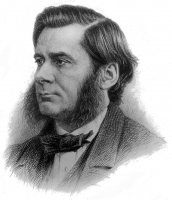| |
托马斯·亨利·赫胥黎,FRS(英语:Thomas Henry Huxley,1825年5月4日-1895年6月29日),英国生物学家,因捍卫查尔斯·达尔文的进化论而有“达尔文的斗牛犬”之称。
他为了对抗理查·欧文的理论而提出的科学论证显示出人类和大猩猩的脑部解剖具有十分的相似性。有趣的是赫胥黎并不完全接受查尔斯·达尔文的许多看法(例如渐进主义),而且,相对于捍卫天择理论,他对于提倡唯物主义科学精神更感兴趣。
作为科普工作的倡导者,他创造了概念“不可知论”来形容他对宗教信仰的态度。
他还因创造了生源论(认为一切细胞皆起源于其他细胞)以及无生源论(认为生命来自于无生命物质)的概念而广为人知。
经历
赫胥黎生于伦敦西部伊令,是当地数学教师乔治·赫胥黎8个孩子中的第7个。17岁时,得到奖学金,开始在查灵十字医院(Charing Cross Hospital)接受正规的医学教育。二十岁时在伦敦大学通过他初次的医学士考试,解剖学及生理学两个科目都得到最优等成绩。1845年他发表了第一篇科学论文,描述了毛发内鞘中迄无人发现的一层构造,此后该层构造即被称为“赫胥黎层”。
之后,赫胥黎前往英国海军谋职,而获得了即将前往托勒斯海峡进行探勘任务的军舰响尾蛇号驻舰外科医官的职位。响尾蛇号于1846年12月3日驶离英国,一抵达南半球,赫胥黎即埋首研究海洋无脊椎动物。他开始将他的发现内容寄回英国。他的一篇论文,“论水母科动物的解剖构造及其间的亲属关系”在1849年被英国皇家学会的“哲学会报”刊出。赫胥黎将Medusae、Hydroid及Sertularian polyps合并为一纲,并将其命名为Hydrozoa纲。他发现此纲生物的共同点是具有由双层膜所包围形成的中央空腔或消化道。这就是现在所称刺胞动物门(Cnidaria)的特征。他并且把这个特征比作存在于较高等动物的胚胎中的浆液性和粘液性构造。
赫胥黎的成就受到肯定,而在1850年返英时获选为皇家学会院士。翌年,他不仅以26岁的年纪获颁皇家奖章,而且还获选为评议会议员。
1883年,赫胥黎郑重的宣称海洋资源不会枯竭,并呼吁政府放宽限制,让渔民尽情捕捞鳕鱼。但由于赫胥黎未能料到后来相关技术的快速发展,最后却导致大西洋鳕鱼面临灭绝的危险。
他的健康状况从1885年开始恶化。1890年他从伦敦搬到港口城市伊斯特本,受尽疾病折磨后在那里去世。
赫胥黎家族是英国著名的学术世家,托马斯·亨利·赫胥黎的孙子朱利安·赫胥黎爵士是联合国教科文组织首任主席并创立了世界自然基金会,朱利安的同母弟弟奥尔德斯·赫胥黎是作家,异母弟弟安德鲁·赫胥黎爵士是生理学家,诺贝尔奖得主。
赫胥黎的传世名言:“试着去学一切的一点皮毛,和某些皮毛的一切。”(Try to learn something about everything and everything about something.)
参见
参考文献
- ^ 有争议。Bibby, Cyril. 1959. T. H. Huxley: scientist, humanist and educator. Watts, London. p. 3–4
外部链接
Thomas Henry Huxley PC FRS HonFRSE FLS (4 May 1825 – 29 June 1895) was an English biologist and anthropologist specialising in comparative anatomy. He is known as "Darwin's Bulldog" for his advocacy of Charles Darwin's theory of evolution.
The stories regarding Huxley's famous debate in 1860 with Samuel Wilberforce were a key moment in the wider acceptance of evolution and in his own career, although historians think that the surviving story of the debate is a later fabrication. Huxley had been planning to leave Oxford on the previous day, but, after an encounter with Robert Chambers, the author of Vestiges, he changed his mind and decided to join the debate. Wilberforce was coached by Richard Owen, against whom Huxley also debated about whether humans were closely related to apes.
Huxley was slow to accept some of Darwin's ideas, such as gradualism, and was undecided about natural selection, but despite this he was wholehearted in his public support of Darwin. Instrumental in developing scientific education in Britain, he fought against the more extreme versions of religious tradition.
Originally coining the term in 1869, Huxley elaborated on "agnosticism" in 1889 to frame the nature of claims in terms of what is knowable and what is not. Huxley states
Use of that term has continued to the present day (see Thomas Henry Huxley and agnosticism). Much of Huxley's agnosticism is influenced by Kantian views on human perception and the ability to rely on rational evidence rather than belief systems.
Huxley had little formal schooling and was virtually self-taught. He became perhaps the finest comparative anatomist of the later 19th century. He worked on invertebrates, clarifying relationships between groups previously little understood. Later, he worked on vertebrates, especially on the relationship between apes and humans. After comparing Archaeopteryx with Compsognathus, he concluded that birds evolved from small carnivorous dinosaurs, a theory widely accepted today.
The tendency has been for this fine anatomical work to be overshadowed by his energetic and controversial activity in favour of evolution, and by his extensive public work on scientific education, both of which had significant effects on society in Britain and elsewhere. Huxley's 1893 Romanes Lecture, “Evolution and Ethics” is exceedingly influential in China; the Chinese translation of Huxley's lecture even transformed the Chinese translation of Darwin's Origin of Species.

